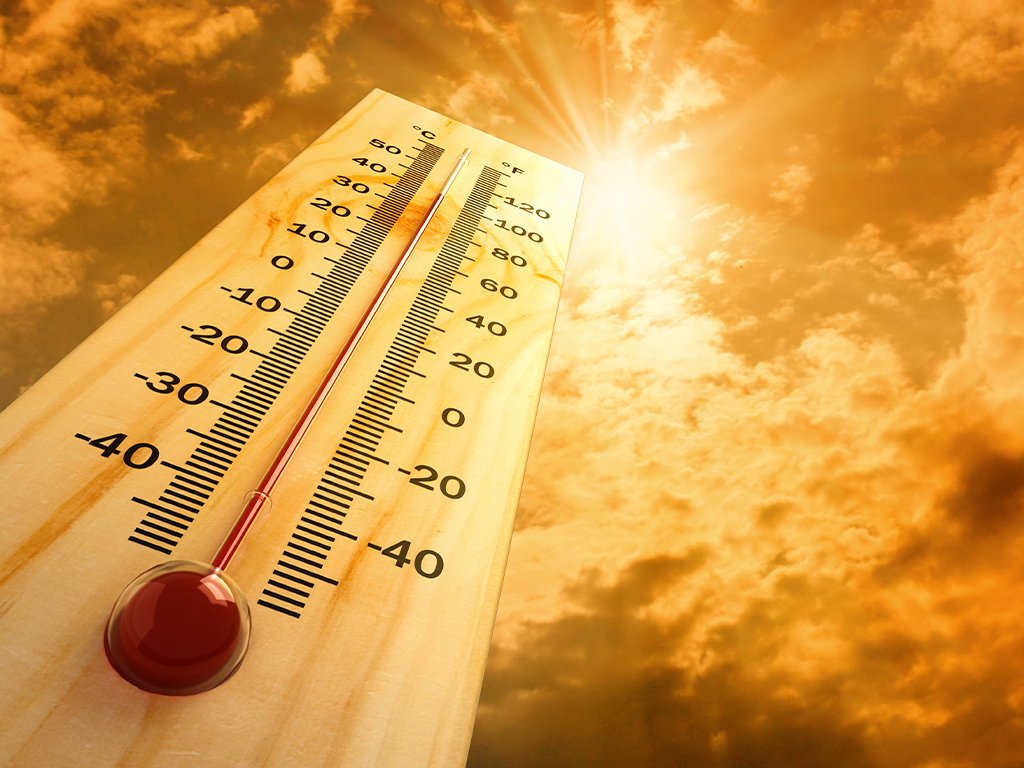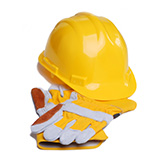June 14, 2021 | Posted by MICRO

Heat stress occurs when the body’s natural cooling mechanisms are overwhelmed by the ambient temperature and warm up too quickly as a result. The CDC describes two different processes that lead to heat stress: classic and exertional.
- Classic heat stress occurs when the body is exposed to high levels of ambient heat (whether indoors or outdoors), even in the absence of physical activity. Traffic controllers in road construction operations are at risk of this type of heat stress. While they don’t perform intensive labor, they are nevertheless exposed to high temperatures both from the sun and the hot asphalt being laid.
- Exertional heat stress, on the other hand, involves physical activity that warms the body. Intensive labor generates large amounts of heat, and this heat can build up faster than the body can dissipate it.
Construction work frequently takes place outdoors and, especially in Canada and the northern parts of the United States, often during the hottest times of the year (to take advantage of the short-lived warm weather). Moreover, most construction work is physically demanding.
This places construction at a compound risk. Because of the nature of their job, most of them are exposed to both classic and exertional risk factors.
Left unchecked, these exposures can lead to a series of heat-related illnesses. Heat stroke is the best known, but workers can also deal with heat exhaustion, heat cramps, and heat rashes.
Moreover, the fatigue and impaired mental abilities associated with heat stress can lead to dangerous mistakes and misunderstandings. The sweaty palms and fogged up safety glasses that can accompany them make matters even worse.
(Find out How to Combat Fogging, the Number One Complaint from Safety Eyewear Users)
Given how much of the work takes place outdoors, heat stress is one of the most common occupational hazards in the construction industry, one that spans across most trades.
The data bears this out. In 2018, according to the Bureau of Labor Statistics Survey of Occupational Injuries and Illness Data, there were 3,120 cases of heat exposure that were serious enough to result in days away from work. Of these, 49 were fatalities where exposure to environmental heat was either the primary or secondary cause of death.
The 2019 and 2020 BLS data are not available yet, but a search for “heat stroke” on OSHA’s website turns up 23 heat stroke fatalities in 2019 and 15 in 2020. Most of these were related to construction activities.
Although heat stress incidents can happen all year round, according to OSHA, 50-70% of the heat stress related fatalities happen at the onset of the hot season, since the body needs time to acclimatize and slowly build tolerance to the heat.
With the start of summer approaching, it’s time to raise awareness and prepare for the hazards associated with the season.
How to Prevent Heat Stress
Prevention is more effective than reactive solutions, and this is especialy true when it comes to heat stress. Preventing heat stress saves lives, unnecessary suffering and keeps projects running on time. Not only that, but if the symptoms are recognized in due time, all of the effects of heat illness are 100% reversible.
It is paramount that employers provide adequate heat stress safety training. In particular, employees shouid know:
- How heat-related illnesses develop and progress.
- Key personal risk factors, including age, cardiac conditions, and the use of certain medications.
- How to work to prevent heat stress.
- How to recognize symptoms of heat-related illnesses.
- What to do if they (or a co-worker) is afflicted by a heat disorder.
While training provides employee awareness, its main role is to help them develop the skills to perform a heat stress assessment that will equip them with the knowledge to ask for and implement heat stress controls.
Engineering Controls for Heat Stress
While some of the heat stress prevention measures are behavioral, there are a few engineering controls that employers should implement on their construction sites.
- Where possible, reducing intensive physical labor by using mechanical equipment, such as moving concrete bags with a skid steer instead of by hand.
- Ensuring that equipment or vehicles are equipped with air conditioning, allowing employees to take breaks or perform some of their work in a cool environment.
- If air conditioning is not available, providing fans for spot cooling.
(Learn more in A Primer on Engineering Controls)
Administrative Controls for Heat Stress
Outdoor construction jobs limit the number of engineering controls you can implement. As such, they should be supplemented by administrative controls, such as the following.
- Allow employees to acclimatize to hot weather by gradually increasing their exposure time and work intensity. Generally, it takes one to three weeks for for our bodies to adjust and adapt.
- If your worksite has a mix of workers who have been acclimatized and workers who haven’t, adjust workloads and tasks accordingly.
- Monitor employees for symptoms of heat stress. At minimum, make sure employees don’t work alone in hot weather. Ideally, each team should have a designated, trained supervisor.
- When possible, arrange tasks so the most demanding work is done during the cooler part of the day or in a shaded area.
- Make sure employees have access to water and encourage them to drink throughout the day instead of waiting until they feel thirsty.
- Create a temperature graph (corrected with the humidity index where needed) that clearly indicates the appropriate work-rest cycles and encourage workers to take breaks as indicated.
Heat Stress PPE
Outdoor workers should reduce the amount of skin surface that is exposed to the sun. So, lightweight, light-colored, loose-fitting, full-length clothing is recommended. Although shorts and t-shirts seem like a natural choice for hot weather work, leaving that much skin exposed to direct sunlight results in more heat absorption.
A wide-brimmed hat is recommended. Employees who need to wear head protection should attach a light-colored neck cover to their hard hats.
In terms of PPE and protective clothing, there are two basic approaches that can help keep workers cool.
Evaporative Cooling
Evaporative cooling is the simplest way to keep workers cool with PPE and mirrors the way our bodies dissipate heat.
It relies on a wet garment to trap the wearer’s body heat and then dissipate it through evaporation as it dries. This works well while the garment is wet and cooler than the body, so the worker will have to frequently wet the garment with cold water to get the full benefit of wearing it.
Regular PPE will provide a cooling effect if it is soaked in cold water, but there are lines of PPE that are specifically designed to offer faster evaporation rates and better cooling, including vests, towels, and hats.
Phase Change Cooling
When there isn’t enough airflow to facilitate evaporation or when it’s so hot that evaporation can’t remove the excess heat quickly enough, workers will need to rely on something better than evaporative cooling.
Phase change equipment is a great option in those situations. This type of cooling equipment relies on cooling packs placed inside a vest. These packs transfer cool temperature to the body and keeps it from overheating.
These cooling packs, however, need to be changed frequently. Keeping extra packs on hand (and a cooling station to store them) can be highly impractical.
(Learn more in How to Use PPE to Combat Heat Stress)
Heat stress is not a condition. Rather, it’s a group of heat-related illnesses that are grouped under a single name because they share the same root cause.
Let’s look at the major ones in order of severity, discuss how they happen, their symtpoms, and how to care for workers who are suffering from these various conditions.
Heat Rush (“Prickly Heat”)
How it happens: The sweat glands allow sweat to exit the body, providing an evaporative cooling effect in the process. However, when these glands become clogged (often due to dirt or inflammation) the sweat can’t reach the surface and begins accumulating under the skin.
Symptoms: Depending on the severity of the reaction, the symptoms vary from clear fluid blisters, red bumps, pus-filled pustules, and goosebump-like firm lesions. Most of these are accompanied by a severe itching sensation.
How to treat it: As soon as the symptoms develop, the employee should be moved to a cool environment. A cool shower followed by drying thoroughly will help alleviate the sensation. The skin should be kept clean to avoid infection. Heat rush normally subsides a few days after exposure.
Heat Cramps
How it happens: Overexertion, especially in warm weather and under several layers of PPE, causes the body to lose salts and moisture through perspiration. If the loss is faster than the speed at which they are replenished, heat cramps will set in.
Symptoms: Painful spasms in large muscles (such as those in the back, legs, arms, or abdomen), accompanied by hard lumps.
How to treat it: The first step is for the affected employee to stop engaging in strenuous activity and sit in a cool place. They should replenish lost fluids and minerals with an electrolyte beverage (such as a sports drink) or juice if none is available. Water and food will also help.
(Learn more about Electrolytes: What They Are and Why They Matter for On-the-Job Hydration)
As the body recovers, the employee should slowly stretch and massage the muscles but should not engage in any strenuous work for at least several hours after the cramps have subsided.
Heat Exhaustion
How it happens: Heat exhaustion results from prolonged exposure to high temperatures (with or without physically intensive activity) leading to dehydration and loss of electrolytes.
Symptoms: Headaches, breathlessness, nausea or vomiting, excessive sweating, general weakness that might result in inability to continue working, mood changes, a higher body temperature, a pale and clammy skin, and fainting.
Heat exhaustion can quickly progress to heat stroke if it is not managed quickly.
How to treat it: Workers afflicted by heat exhaustion respond quickly to first aid. If the intervention happens in time, the recovery rate is 100%. It is important to quickly cool off the employee’s body by moving them to a cool, shaded area, removing unnecessary clothing, applying a cool, wet towel or garment, and providing them with plenty of cool fluids.
It takes at least 30 minutes for a victim of heat exhaustion to rebalance their body temperature. They should be monitored closely and 911 should be called if their condition worsens or shows no apparent improvement within 15 minutes.
Heat Stroke
How it happens: Heat stroke is the most severe of all the heat-related illnesses and sets in when the body’s cooling mechanisms are overwhelmed and can no longer control its core temperature.
Symptoms: High body temperature, confusion and impaired coordination, headache, seizures or non-responsiveness (coma), nausea and vomiting. The condition of the skin is a poor indicator, since it can be either hot and dry or sweating profusely.
How to treat it: A heat stroke is a medical emergency. If it is not treated immediately, it can be fatal or permanently disabling.
Call 911 immediately. While waiting for EMS, try to cool the employee with whatever means are available – anything from cooling packs and cool garments to a cold bath or even a garden hose. Continue cooling the employee down until EMS arrives or the employee starts shivering.
Conclusion
Many construction workers take heat stress too lightly. The heat and its effects are often seen as part of the job. And while most cases of heat stress do not result in irreversible damage or death, heat stress injury and fatality statistics show that it is a hazard that should be taken seriously.
Employers must create plans for working in hot weather that are clear, simple to follow, and do not rely on the employee’s self-pacing. These plans should include training regarding heat stress, adequate work/rest schedules, and a combination of hazard controls that will ensure that the employee’s body temperature does not rise to hazardous levels.
Written by Karoly Ban Matei | HR and Safety Manager

Karoly has worked at a senior level (both as an employee and a contractor) for organizations in the construction and manufacturing industries. He has a passion for developing and improving health and safety programs.



 (
(